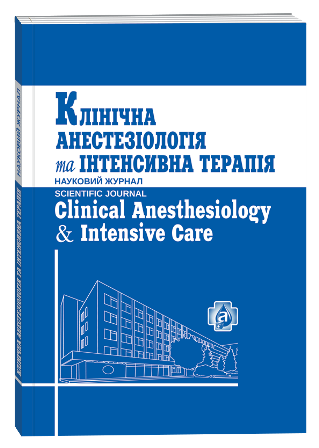ТУЧНЫЕ ПАЦИЕНТЫ: АНЕСТЕЗИОЛОГИЧЕСКИЕ ПРОБЛЕМЫ
DOI:
https://doi.org/10.31379/2411.2616.11.1.1Ключові слова:
ожирение, анестезия, патофизиологияАнотація
В эпоху всемирной эпидемии ожирения люди с избыточной массой тела обычно становятся пациентами анестезиолога. Анатомическое распределение излишнего жира в организме проводит к многочисленным патофизиологическим последствиям, особенно от этого страдает сердечно-легочная система. Данные изменения могут непосредственно влиять на периоперационный курс, поэтому должны быть оценены. Ожирение связано с многочисленными сопутствующими заболеваниями, в связи с этим особое внимание нужно уделить тщательному изучению истории болезни пациента и физическому осмотру его до операции. В этой статье рассматривается вопрос об обеспечении безопасной анестезии страдающему ожирением пациенту. Также обсуждаются физиологические эффекты ожирения и важные предоперационные, интраоперационные и послеоперационные проблемы.
Посилання
Koenig S. M. Pulmonary complications of obesity. Am J Med Sci. 2001. № 321. P. 249–279.
Murugan A. T., Sharma G. Obesity and respiratory diseases. Chron Respir Dis. 2008. № 5. P. 233–242.
Cardiovascular evaluation and management of severely obese patients undergoing surgery: a science advisory from the American Heart Association / P. Poirier et al. Circulation. 2009. № 120. P. 86–95.
Barash P. G. Clinical anesthesia. 6th ed. Philadelphia: Wolters Kluwer/Lippincott Williams & Wilkins. 2009. № 34. P. 65.
Kokkoris P., Pi-Sunyer F. X. Obesity and endocrine disease. Endocrinol Metab Clin North Am. 2003. № 32. P. 895–914.
Douyon L., Schteingart D. E. Effect of obesity and starvation on thyroid hormone, growth hormone, and cortisol secretion. Endocrinol Metab Clin North Am. 2002. № 31. P. 173–189.
Prevalence of subclinical hypothyroidism in a morbidly obese population and improvement after weight loss induced by Roux-en-Y gastric bypass / C. M. Moulin de Moraes et al. Obes Surg. 2005. № 15. P. 1287–1291.
Reinehr T., Andler W. Thyroid hormones before and after weight loss in obesity. Arch Dis Child. 2002. № 87. P. 320–323.
Rosenberg D. E., Jabbour S. A., Goldstein B. J. Insulin resistance, diabetes and cardiovascular risk: approaches to treatment. Diabetes Obes Metab. 2005. № 7. P. 642–653.
Obesity and estrogen as risk factors for gastroesophageal reflux symptoms / M. Nilsson et al. JAMA. 2003. № 290. P. 66–72.
Hepatic decompensation after gastric bypass surgery for severe obesity / S. J. Cotler et al. Dig Dis Sci. 2004. № 49. P. 1563–1568.
Modest weight loss and physical activity in overweight patients with chronic liver disease results in sustained improvements in alanine aminotransferase, fasting insulin, and quality of life / I. J. Hickman et al. Gut. 2004. № 53. P. 413–419.
The effects of weight loss on renal function in patients with severe obesity / A. Chagnac et al. J Am Soc Nephro. 2003. № 14. P. 1480–1486.
Glomerular hemodynamics in severe obesity / A. Chagnac et al. Am J Physiol Renal Physiol. 2000. № 278. P. 817–822.
Hall J. E. The kidney, hypertension, and obesity. Hypertension. 2003. № 41. P. 625–633.
Obesity and laparoscopic repair of ventral hernias / G. Birgisson et al. Surg Endosc. 2001. № 15. P. 1419.
Outcomes of laparoscopic donor nephrectomy in obese patients / P. C. Kuo et al. Transplantation. 2000. № 69. P. 180–182.
Anesthetic management of morbidly obese and super-morbidly obese patients undergoing bariatric operations: hospital course and outcomes / Y. Leykin et al. Obes Surg. 2006. № 16. P. 1563–1569.
Neligan P. J. Metabolic syndrome: anesthesia for morbid obesity. Curr Opin Anaesthesiol. 2010. № 23. P. 375–383.
Unrecognized sleep apnea in the surgical patient: implications for the perioperative setting / R. Kaw et al.. Chest. 2006. № 129. P. 198–205.
The obesity-hypoventilation syndrome revisited: a prospective study of 34 consecutive cases / R. Kessler et al. Chest. 2001. № 120. P. 369–376.
Isono S. Obesity and obstructive sleep apnoea: mechanisms for increased collapsibility of the passive pharyngeal airway. Respirology. 2012. № 17. P. 32–42.
Isono S. Obstructive sleep apnea of obese adults: pathophysiology and perioperative airway management. Anesthesiology. 2009. № 110. P. 908–921.
O’Keeffe T., Patterson E. J. Evidence supporting routine polysomnography before bariatric surgery. Obes Surg. 2004. № 14. P. 23–26.
Lopez P. P., Stefan B., Schulman C. I., Byers P. M. Prevalence of sleep apnea in morbidly obese patients who presented for weight loss surgery evaluation: more evidence for routine screening for obstructive sleep apnea before weight loss surgery. Am Surg. 2008. № 74. P. 834–838.
A prospective study of age and lifestyle factors in relation to community-acquired pneumonia in US men and women / I. Baik et al. Arch Intern Med. 2000. № 160. P. 3082–3088.







